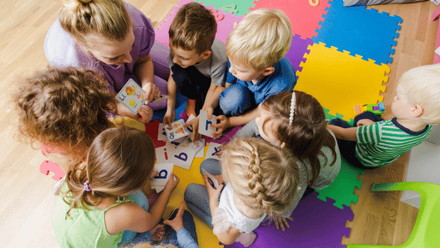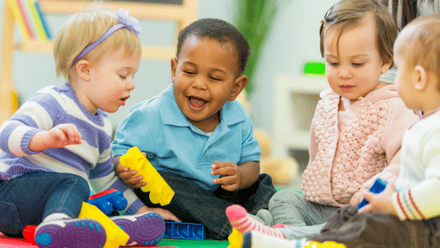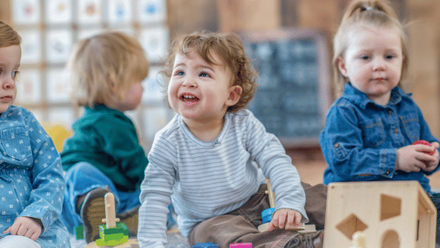How to develop in your role as key person towards inclusive education
Building meaningful connections and secure attachments has long been proven to have a profound impact on child development and wellbeing. Whilst there have been criticisms of the original research from which attachment theory emerged, it is well documented that providing a safe, loving and secure environment for children to build genuine bonds with their caregivers is paramount to their future outcomes.
The role of the key person, or key worker, aims to build upon these values by encouraging a strong attachment to a particular educator who gets to know their individual nature, family dynamics and support them to grow throughout their time in the setting, using a person-centred approach to ensure their needs are fully met.
For children with additional needs, establishing a core relationship with a specific person creates a safe space in which they can begin to build a trusting partnership. It is especially helpful to provide as much consistency as possible for children with SEND, ALN, or ASL. Just as we aim to establish core routines to encourage independence and support understanding of the world around them, using the key person approach allows us to strengthen familiarity and help them to thrive with us. From daily transitions to celebrating big milestones, the key person is there for it all!
In this article, we are looking at what the key person approach can do to support inclusive educational practice and offer some tips for putting this into place yourself.
What is a key person?
In England, it is statutory that every child is assigned a key person when they attend an early education and care provision. According to the statutory guidance:
Their role is to help ensure that every child’s care is tailored to meet their individual needs, to help the child become familiar with the setting, offer a settled relationship for the child and build a relationship with their parents and/or carers. They should also help families and engage with more specialist support if appropriate.
The key person has a responsibility to cultivate a welcoming environment and use approachable communication to build meaningful connections with the children and their families. They are a constant within the setting who are able to coordinate observations, plan relevant learning opportunities and take a special interest in their individual development. As a key person, your responsibility lies in building, and sustaining, a strong relationship with children in which they feel safe and valued in your care. The role and responsibilities of a key person are well-established within early education and care practice but how does the key-person approach benefit children with special educational needs and disabilities?
The role of the key person is an essential one for ensuring healthy development within the early education and care environment, but it is especially so for supporting children with additional needs from the very earliest stages.
Many children with additional needs may struggle with transitions, both day to day and further afield. Having a dependable and predictable person to share their daily interactions creates a space in which to feel supported and regulated and better cope with unexpected changes to routine. To a child with SEND, ALN or ASL, a reliable key person can revolutionise their experience within early education and care settings.
How to develop your role as a key person with additional needs in mind
The Key Person Approach is valuable for supporting all children through their early education and care journey but is particularly so for children with additional needs or disabilities.
Recognising additional
The role of the key person involves responsibility for formative assessment and observation of a child’s learning, planning enriching learning opportunities to extend their thinking and encourage them to grow. This daily interaction with a child’s cognition and learning can often mean the key person is one of the first to identify when a child might be struggling to access a part of the provision or isn’t meeting milestones as expected.
-
When observing young children’s behaviour, be mindful of the context as much as the behaviours shown. Children with sensory processing differences might show signs of distress in particular environments, for example. Keeping an open mind to think about the moment from the child’s perspective can help us to understand why things might be happening as they are in a child-centred way.
Supporting transitions
Transitions into new and unfamiliar environments can be a challenge for anyone, especially young children. For children with special educational needs and disabilities, changes to regular routine can cause a great deal of anxiety and distress. It is vital that the key person plays a proactive and empathetic role, regardless of the size of the transition, to support children through new changes by taking a compassionate stance that aims to reassure and help children to work through their feelings.
-
Using communication support resources, such as visual timetables or practical objects can help to convey meaningful aspects of a transition to a young child with communication needs. This might involve 1-1 interactions with a visual timetable when the day changes at last minute or introducing school equipment much earlier on in the year to create a better understanding and familiarity with an upcoming transition to school.
Liaising with multi-agencies
For children with more severe special educational needs and disabilities, multi-agency partnerships are an asset to supporting a child and their family. For children with communication needs, for example, external speech and language therapists may work with the family to support language development. Children with mental health problems and emotional needs might benefit from interactions with a play therapist. Children with extensive physical health needs might also visit a physiotherapist. Regardless of the agency working in partnership, the early education and care setting provides a good standpoint for gaining a professional insight into the child’s progress and wellbeing. The key person holds a valuable amount of information and personal knowledge about their key children and so they play a prime role in effective partnership with external agencies.
-
As a key person, it is your responsibility to ensure observations are up to date and accurate. This is not only to record learning outcomes and share activities with parents, but it also provides a rich history on a child’s development and behaviour if they are involved with other agencies.
Parent and carer contact
Early education and care professionals do an incredible job, but it is the role of the parent or carer that has the most powerful influence on a child’s learning outcomes. Establishing parent partnerships is key to the success of any child in early education and care but especially so for children who also have additional needs within the provision. Maintaining an open and trusting dialogue with those at home allows all adults to support children to grow and, for children with additional needs. Closely monitoring progress and behaviours contribute to understanding their needs on a deeper level, which can be tricky to do when a young child is unable to articulate their needs.
-
Be honest and open with parents and carers to establish an accurate picture of a child’s needs. It can sometimes be difficult to talk to a parent or carer about a distressing situation involving their child, but it is important to emphasise that your role as a key person has their child at the heart of your practice. Keeping things transparent is the only way effective partnerships and meaningful provision support can take place.
The key person really makes a difference
The key person is the adult in setting that a child goes to when they are hurt, the one a toddler talks incessantly about on the way home, the one that the baby cries for when they leave the room. They are the trusted, dependable, loved professional who builds a genuine connection with each child in their care and holds their best interests at the heart of everything they do.
For children with additional needs and disabilities, the importance of this role grows stronger every day. In order to support every child in our care effectively, a sensitive, inclusive key person approach should be used to ensure every child is advocated for equally.
Reflection...
Have a look at your job description. If you can’t find it or do not currently work directly with children, you can find an example here.
What does the description say about working with children with additional needs? Does this align with your own experience of the role or with what you read in this article? Is there anything you would change?





